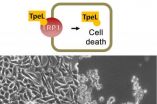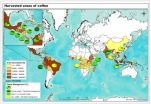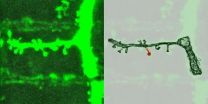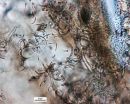(Press-News.org) Prof. Dr. Dr. Klaus Aktories and Dr. Panagiotis Papatheodorou from the Institute of Experimental and Clinical Pharmacology and Toxicology of the University of Freiburg have discovered the receptor responsible for smuggling the toxin of the bacterium Clostridium perfringens into the cell. The TpeL toxin, which is formed by C. perfringens, a pathogen that causes gas gangrene and food poisoning. It is very similar to the toxins of many other hospital germs of the genus Clostridium. The toxins bind to surface molecules and creep into the body cell, where they lead to cell death. "In order to prevent the toxin from entering the cell, it is necessary to find the receptor that serves as the gatekeeper. But the search for this key molecule remained unsuccessful for a long time," says Aktories, member of the Cluster of Excellence BIOSS Centre for Biological Signalling Studies. In cooperation with colleagues from Düsseldorf, the USA, and the Netherlands, the researchers from Freiburg have now identified a receptor for a clostridial toxin of this type for the first time ever. Their findings were published in the journal Proceedings of the National Academy of Sciences (PNAS).
Clostridia cause intestinal and wound diseases in humans and animals that are often fatal. "At the moment, infections with the bacterium Clostridium difficile are particularly problematic in hospitals. The diseases tend to appear following treatment with antibiotics and often lead to diarrhea, but also to fatal inflammations of the bowels," explains Aktories. The toxins force their way into host cells and deactivate signaling molecules by attaching a sugar molecule to these cellular switches. Once this signaling pathway has been switched off, the cell dies – infested tissue dies off.
In order to find the receptor, the researchers applied a genetic selection procedure, a so-called screening, in which individual genes in cells from human cancer cell lines are turned off at random. This procedure led to the discovery that cells are immune to the TpeL toxin when the gene for the protein LRP1 is switched off on the cell surface. LRP1, which stands for low density lipoprotein receptor-related protein 1, usually takes in proteins that serve as a means of transport for lipidsfats in the blood. The researchers demonstrate that LRP1 is the long sought-after key molecule: It also regulates the intake of the toxin TpeL.
His team also proposes a new model, explains Aktories: "Our findings indicate that two receptors are involved in the effect of the other sugar-carrying clostridial toxins." Researchers can use the findings to develop new agents against clostridia. "Our discovery will also provide new impetus for researchers to identify further toxin receptors," Aktories hopes.
INFORMATION:
Original publication:
Björn Schorch, Shuo Song, Ferdy R. van Diemen, Hans H. Bock, Petra May, Joachim Herz, Thijn R. Brummelkamp, Panagiotis Papatheodorou and Klaus Aktories
LRP1 is a receptor for Clostridium perfringens TpeL toxin indicating a two-receptor model of clostridial glycosylating toxins.
PNAS 2014 ; published ahead of print April 15, 2014, doi:10.1073/pnas.1323790111
More Information on the BIOSS Centre for Biological Signalling Studies:
http://www.bioss.uni-freiburg.de/cms/index.php
Gate for bacterial toxins found
Freiburg researchers discover a molecule that smuggles toxins from intestinal pathogens into human cells
2014-04-16
ELSE PRESS RELEASES FROM THIS DATE:
Scientists explain how memories stick together
2014-04-16
LA JOLLA—Scientists at the Salk Institute have created a new model of memory that explains how neurons retain select memories a few hours after an event.
This new framework provides a more complete picture of how memory works, which can inform research into disorders liked Parkinson's, Alzheimer's, post-traumatic stress and learning disabilities.
"Previous models of memory were based on fast activity patterns," says Terry Sejnowski, holder of Salk's Francis Crick Chair and a Howard Hughes Medical Institute Investigator. "Our new model of memory makes it possible to ...
Shade grown coffee shrinking as a proportion of global coffee production
2014-04-16
The proportion of land used to cultivate shade grown coffee, relative to the total land area of coffee cultivation, has fallen by nearly 20 percent globally since 1996, according to a new study by scientists from The University of Texas at Austin and five other institutions.
The study's authors say the global shift toward a more intensive style of coffee farming is probably having a negative effect on the environment, communities and individual farmers.
"The paradox is that there is greater public interest than ever in environmentally friendly coffee, but where coffee ...
Synapses -- stability in transformation
2014-04-16
This news release is available in German. Synapses are the points of contact at which information is transmitted between neurons. Without them, we would not be able to form thoughts or remember things. For memories to endure, synapses sometimes have to remain stable for very long periods. But how can a synapse last if its components have to be replaced regularly? Scientists from the Max Planck Institute of Neurobiology in Martinsried near Munich have taken a decisive step towards answering this question. They have succeeded in demonstrating that when a synapse is formed, ...
Scratching the surface: Microbial etchings in impact glass and the search for life on Mars
2014-04-16
Boulder, Colo., USA – Haley M. Sapers and colleagues provide what may be the first report of biological activity preserved in impact glass. Recent research has suggested that impact events create novel within-rock microbial habitats. In their paper, "Enigmatic tubular features in impact glass," Sapers and colleagues analyze tubular features in hydrothermally altered impact glass from the Ries Impact Structure, Germany, that are remarkably similar to the bioalteration textures observed in volcanic glasses.
The authors note that mineral-forming processes cannot easily ...
Cancer drugs block dementia-linked brain inflammation, UCI study finds
2014-04-16
Irvine, Calif., April 16, 2014 — A class of drugs developed to treat immune-related conditions and cancer – including one currently in clinical trials for glioblastoma and other tumors – eliminates neural inflammation associated with dementia-linked diseases and brain injuries, according to UC Irvine researchers.
In their study, assistant professor of neurobiology & behavior Kim Green and colleagues discovered that the drugs, which can be delivered orally, eradicated microglia, the primary immune cells of the brain. These cells exacerbate many neural diseases, including ...
Recycling industrial waste water
2014-04-16
A research group composed of Dr. Martin Prechtl, Leo Heim and their colleagues at the University of Cologne's Department of Chemistry has discovered a new method of generating hydrogen using water and formaldehyde. The generation of hydrogen from liquids is of particular interest when it comes to fuel cell technologies. The results of the project, entitled "Selective and mild hydrogen production using water and formaldehyde", have recently been published in the journal Nature Communications.
Among other applications, the new approach can be used to recycle industrial ...
Research uncovers DNA looping damage tied to HPV cancer
2014-04-16
It's long been known that certain strains of human papillomavirus (HPV) cause cancer. Now, researchers at The Ohio State University have determined a new way that HPV might spark cancer development – by disrupting the human DNA sequence with repeating loops when the virus is inserted into host-cell DNA as it replicates.
Worldwide, HPV causes about 610,000 cases of cancer annually, accounting for about five percent of all cancer cases and virtually all cases of cervical cancer. Yet, the mechanisms behind the process aren't yet completely understood.
This study, recently ...
New type of barcode could make counterfeiters' lives more difficult
2014-04-16
Counterfeiters, beware! Scientists are reporting the development of a new type of inexpensive barcode that, when added to documents or currency, could foil attempts at making forgeries. Although the tags are easy for researchers to make, they still require ingredients you can't exactly find at the local hardware store. Their report appears in the Journal of the American Chemical Society.
Xiaogang Liu and colleagues explain that scientists have used fluorescent and DNA-based barcodes, or tags of known composition and sequence, in attempts to develop tests for cancer and ...
A greener source of polyester -- cork trees
2014-04-16
On the scale of earth-friendly materials, you'd be hard pressed to find two that are farther apart than polyester (not at all) and cork (very). In an unexpected twist, however, scientists are figuring out how to extract a natural, waterproof, antibacterial version of the first material from the latter. Their new technique, which could have applications in medical devices, appears in the ACS journal Biomacromolecules.
Cristina Silva Pereira and colleagues explain that polyesters are ubiquitous in modern life, and not just as a practical fabric for clothing. Their durability ...
Local homicide rate increases cause more elementary students to fail school
2014-04-16
WASHINGTON, DC, April 16, 2014 — A new study finds that an increase in a municipality's homicide rate causes more elementary school students in that community to fail a grade than would do so if the rate remained stable.
"This finding is a source of concern because exposure to environmental violence is highly prevalent in contemporary societies and is unequally distributed along socioeconomic lines," said study co-author Florencia Torche, an associate professor of sociology at New York University. "To the extent that children living in poverty are more likely to experience ...
LAST 30 PRESS RELEASES:
Post-stroke injection protects the brain in preclinical study
Cardiovascular risk score predicts multiple eye diseases
Health: estimated one in ten British adults used or interested in GLP-1 medications for weight loss
Exercise to treat depression yields similar results to therapy
Whooping cough vaccination for pregnant women strengthens babies’ immune system
Dramatic decline in new cases of orphanhood in Uganda driven by HIV treatment and prevention programs
Stopping weight loss drugs linked to weight regain and reversal of heart health markers
Higher intake of food preservatives linked to increased cancer risk
Mass General Brigham–developed cholera vaccine completes phase 1 trial
First experimental validation of a “150-year-old chemical common sense” direct visualization of the molecular structural changes in the ultrafast anthracene [4+4] photocycloaddition reaction
Lack of support for people on weight loss drugs leaves them vulnerable to nutritional deficiencies, say experts
Dogs’ dinners can have greater climate impact than owners’
Are you ready to swap salmon for sprats and sardines?
1.6 million UK adults used weight loss drugs in past year
American College of Cardiology comments on new dietary guidelines for Americans
American Society of Gene & Cell Therapy and Orphan Therapeutics Accelerator partner to advance and commercialize promising rare disease treatments
One in 14 patients having day case surgery have new or worse chronic pain 3 months after their operation
New study highlights link between eviction rates and gun violence
Heatwaves heat up soil but not toxin levels in rice, study finds
Digital modeling reveals where construction carbon emissions really come from
Turning farm waste into water filters
New study shows how the spleen helps the immune system accept a transplant
New Mayo Clinic study advances personalized prostate cancer education with an EHR-integrated AI agent
Researchers identify novel therapeutic target to improve recovery after nerve injury
Microbes in breast milk help populate infant gut microbiomes
Reprogramming immunity to rewrite the story of Type 1 diabetes
New tool narrows the search for ideal material structures
Artificial saliva containing sugarcane protein helps protect the teeth of patients with head and neck cancer
Understanding the role of linear ubiquitination in T-tubule biogenesis
Researchers identify urban atmosphere as primary reservoir of microplastics
[Press-News.org] Gate for bacterial toxins foundFreiburg researchers discover a molecule that smuggles toxins from intestinal pathogens into human cells





